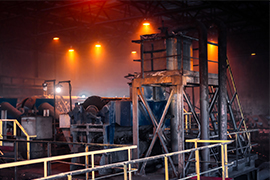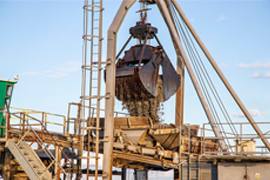In today's world of bulk material transfer, optimizing the process flow is essential to maximize throughput and enhance equipment efficiency. Tega comprehends the intricate challenges involved in this endeavor and engineers impeccable solutions that significantly impact overall productivity and equipment performance.
When designing material flow equipment for optimal performance, certain fundamental criteria form the basis for the creation of an efficient conveyor chute. These criteria are critical for ensuring a smooth and efficient material transfer process:
- Flow Direction Control: Managing the direction of material flow is vital for efficient conveyor chutes and conveyor discharge chutes.
- Flow Stream Control: Controlling the flow stream ensures a consistent and efficient material transfer in both conveyor chutes and conveyor discharge chutes.
- Clogging-Free Equipment: Preventing clogs in the conveyor chutes and conveyor discharge chutes is essential to maintain uninterrupted material flow.
- Flow at Constant Velocity: Maintaining a steady material flow velocity in the conveyor chutes and conveyor discharge chutes is crucial for efficiency.
- Control Spillage: Minimizing spillage in both conveyor chutes and conveyor discharge chutes is essential to reduce wastage and ensure clean operation.
- Low Turbulence among the Material: Reducing turbulence among materials in conveyor chutes and conveyor discharge chutes aids in smoother transfer.
- Material Flow Retardation and Control: Controlling the material flow rate in both conveyor chutes and conveyor discharge chutes is essential for process optimization.
- Uniform Wear Rate: Ensuring uniform wear on conveyor chute and conveyor discharge chute components enhances their longevity.
- Reduce Product Degradation: Preventing product degradation during transfer in both conveyor chutes and conveyor discharge chutes is crucial for quality.
- Material Flow at Desired Velocity: Maintaining the desired material flow velocity in conveyor chutes and conveyor discharge chutes is key to efficiency.
- Dust and Environment Pollution Control: Controlling dust emissions and environmental impact in both conveyor chutes and conveyor discharge chutes is essential for sustainability.
All these factors are carefully considered when designing an optimal conveyor chute and conveyor discharge chute material transfer system. Several factors need to be streamlined and assessed during the design process:
- Material Properties: Understanding the characteristics of the materials being transferred in conveyor chutes and conveyor discharge chutes is vital.
- Velocity of Bulk Stream: The speed of the bulk material stream in both conveyor chutes and conveyor discharge chutes is a critical parameter.
- Feeding Arrangement of Materials: How materials are fed into conveyor chutes and conveyor discharge chutes affects the overall transfer.
- Receiving Arrangements: The setup at the receiving end of conveyor chutes and conveyor discharge chutes is essential for efficient transfer.
- Properties of Installed Liner: The choice of liner material and its properties impact performance in both conveyor chutes and conveyor discharge chutes.
- Configuration of the Chute: The design of the conveyor chute and conveyor discharge chute itself plays a crucial role.
- Structural Layout for Constraints: The structural layout of conveyor chutes and conveyor discharge chutes should account for space and operational constraints.
- Hydraulic Diameter: Considering the hydraulic diameter is important for fluid dynamics in both conveyor chutes and conveyor discharge chutes.
To achieve a continuous, silent, and free-flowing material transfer in both conveyor chutes and conveyor discharge chutes, Tega employs an advanced doctor-patient model framework. This framework offers superior control of material streams in conveyor chutes and conveyor discharge chutes while minimizing air movement, resulting in smoother flow, extended equipment life, increased availability, reduced degradation, dust emission reduction, minimal spillage, reduced jamming, and lower sound pollution. The design process is data-driven, utilizing techniques such as Discrete Element Method (DEM) and ANSYS simulations, along with various numerical models to analyze wear life and ensure efficient liner selection in both conveyor chutes and conveyor discharge chutes.
- Tega's approach follows five key design objectives to guide material onto a conveyor belt in both conveyor chutes and conveyor discharge chutes, matching its speed and direction:
- Eliminate Spillage: Preventing material spillage in both conveyor chutes and conveyor discharge chutes is a top priority.
- Enclose Material Dribbles: Ensuring containment of material dribbles in both conveyor chutes and conveyor discharge chutes is essential.
- Provide Access for Inspection and Maintenance: Accessibility for inspections and maintenance in both conveyor chutes and conveyor discharge chutes is crucial.
- Eliminate Dust Liberation: Minimizing dust liberation in both conveyor chutes and conveyor discharge chutes enhances environmental friendliness.
Tega's comprehensive solutions for transfer points in both conveyor chutes and conveyor discharge chutes draw on specific aspects and decades of experience in bulk material handling at transfer points. This commitment to excellence ensures efficient and reliable conveyor chutes and conveyor discharge chutes for a wide range of industries.



